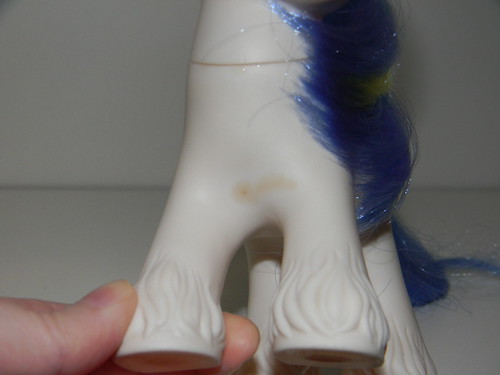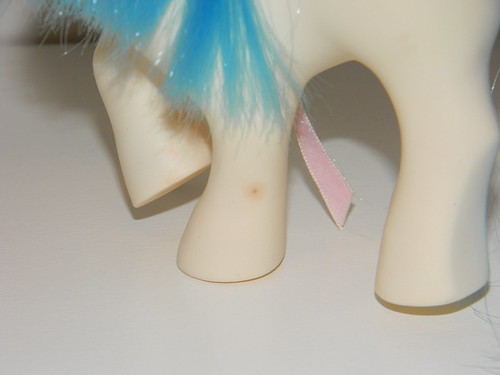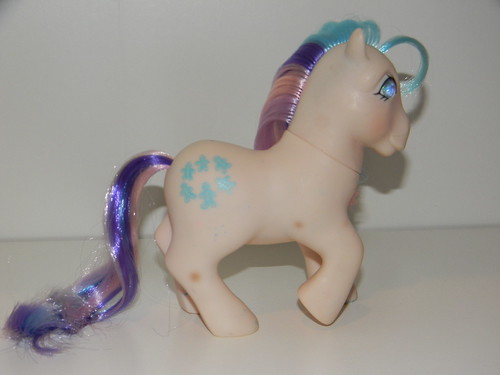The unfortunate truth about vintage Ponies is that very few of these 30+ year old toys has made it this far without sustaining some kind of damage. The even more unfortunate truth is that we're only going to see more damage coming out on these beloved friends as time passes. In the next few weeks, I'm going to explore some of the more common problems that we see in vintage ponies, with an eye toward educating new collectors and warning FIM fans about what they might expect from their Ponies in the coming years.
Vinyl Breakdown
There are a couple of different symptoms of vinyl breakdown. Probably the most common and most noticeable is colloquially known as "pony cancer." This appears as brownish spots on the body of the pony, often, but not always, with a darker brown spot in the centre. Certain ponies are more prone to this type of discolouration, to the point where it is difficult to find an example without at least one brown spot (in the G1s, Chief, Majesty, and Gingerbread, all pictured below, are extremely prone to this). It is a symptom of the plastic aging and discolouring, but it can be aggravated by conditions of high humidity, heat, and a lack of air circulation.
There is a entrenched belief among some collectors that pony cancer can spread throughout a herd. This is not actually true, a pony with cancer can be stored/displayed safely with other ponies without fear of the brown spots spreading. However, if your herd is kept in the less than ideal conditions listed above, cancer can begin to develop more quickly in ponies that previously looked clean. I suspect that this is the reason people believe it spreads from pony to pony.
Unfortunately, there is no way to correct this problem once it has developed. Storing/displaying your pony in a cool climate with good air circulation will help to keep it at bay, but will not necessarily keep it out of your herd completely. Thus far, I don't believe any G4s have been found with this type of vinyl breakdown. The G2s, like the G4s, are made of a slightly harder plastic, and seem to be less prone to pony cancer, so we might hope that the G4s will fare the same.This form of vinyl breakdown is also fairly common, but difficult to photograph. Generally, the pony's appearance doesn't change, but her body gradually becomes sticky. You can wash the stickiness away, but it will gradually come back. This is the "plasticizer," the chemical that makes the plastic soft, leaching out. Eventually all the plasticizer will have leached out, and the pony's body will become extremely hard. Although an irritating flaw, the appearance of the pony doesn't generally change, so this might be a flaw that's easier to live with.
Some G3 ponies, like Candy Apple above, are already becoming sticky. Most G2 ponies (there are exceptions) seem to be less prone to this flaw, again perhaps because they are made of a harder plastic to begin with. It is to be hoped that the G4s will fare similarly.
Elf





No comments:
Post a Comment